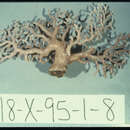Comprehensive Description
provided by Smithsonian Contributions to Zoology
Lepidotheca macropora
DESCRIPTION.—Of the nine branch fragments available for study, tallest branch 4.3 cm, broadest fragmentary colony (holotype) 3.3 cm wide, and greatest basal branch diameter 5.7 mm. Terminal branches slender, about 1.75 mm in diameter. Branching axils U-shaped. Coenosteum white. Coenosteal strips flat, about 0.16 mm wide, and bordered by large, deep, elliptical to elongate, coenosteal pores 50–65 μm wide. Platelets broad, often as wide as coenosteal strip; each longitudinally carinate, having 5–9 low, rounded ridges.
Gastro- and dactylopores randomly arranged on larger diameter branches, but both pore types concentrated on lateral branch edges of slender distal branches. Gastropores elliptical, about 0.41 × 0.29 mm in diameter, the greater axis aligned with branch axis; no lower lips. Gastropore tube long and cylindrical; no ring palisade or tabulae. Gastrostyle long, slender, and pointed; illustrated style 0.95 mm tall and 0.10 mm in diameter (H : W = 9.5). Basal half of style smooth; upper half longitudinally ridged, with short spines about 36 μm long arranged on the ridges. Dactylopore spines infrequent and very small (thus easily overlooked): about 0.10 mm broad and equally tall, with a slit width of about 0.061 mm. On large diameter branches dactylopore spines almost flush with coenosteum.
Female ampullae large hemispheres up to 1.4 mm in diameter with efferent pores up to 0.33 mm in diameter. A short efferent tube is sometimes present. Male ampullae low bulges in coenosteum, about 0.89 mm in diameter. On large diameter branches male ampullae almost entirely internal, evidenced only by low bulges in coenosteum. Male ampullae covered by coenosteal strips separated by slits of greater than average width, the latter of which are infilled by a porous deposit. Discrete efferent pores not observed. Both types of ampullae concentrate on anterior and posterior branch faces.
- bibliographic citation
- Cairns, Stephen D. 1986. "Stylasteridae (Hydrozoa: Hydroida) of the Galapagos Islands." Smithsonian Contributions to Zoology. 1-42. https://doi.org/10.5479/si.00810282.426
Biology
provided by World Register of Marine Species
calcareous colonies, no free medusae
van der Land, J. (ed). (2008). UNESCO-IOC Register of Marine Organisms (URMO).
- license
- cc-by-4.0
- copyright
- WoRMS Editorial Board
Depth range
provided by World Register of Marine Species
166-806 m
Cairns, S.D., 1986. Stylasteridae (Hydrozoa: Hydroida) of the Galapagos Islands. Smithsonian Contributions to Zoology 426: 1-42.
- license
- cc-by-4.0
- copyright
- WoRMS Editorial Board

